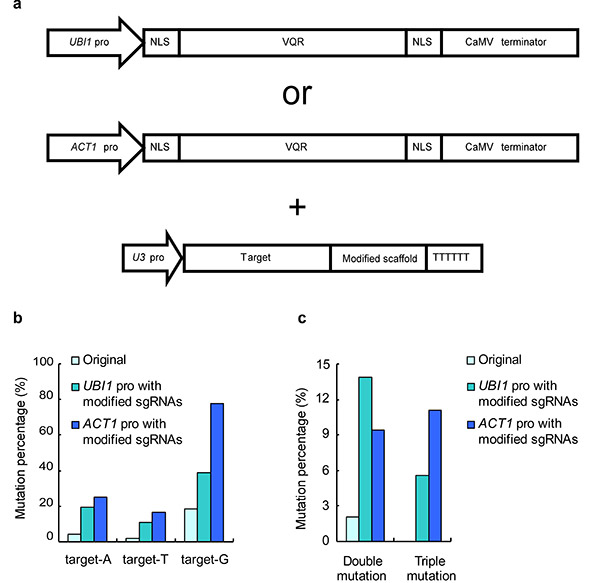






Increasing the efficiency of CRISPR-Cas9-VQR precise genome editing in rice
June 21st, 2017
Clustered regularly interspaced short palindromic repeats-associated protein 9 (CRISPR-Cas9) is a revolutionary technology that enables efficient genomic modification in many organisms. Currently, the wide use of Streptococcus pyogenes Cas9 (SpCas9) primarily recognises sites harbouring a canonical NGG protospacer adjacent motif (PAM). The newly developed VQR (D1135V/R1335Q/T1337R) variant of Cas9 has been shown to cleave sites containing NGA PAM in rice, which greatly expanded the range of genome editing(Hu et al., 2016. Molecular Plant). However, the low editing efficiency of the VQR variant remains, which limits its wide application in genome editing.
Recently, researchers from China National Rice Research Institute (CNRRI), Chinese Academy of Agricultural Sciences and Institute of Genetics and Developmental Biology (IGDB),Chinese Academy of Sciences significantly increased the editing efficiency of the VQR variant by modifying the single guide RNA (sgRNA) structure and using strong endogenous promoters. The modified CRISPR-Cas9-VQR system provides a robust toolbox for multiplex genome editing at sites containing non-canonical NGA PAM.
This work was supported by the National Natural Science Foundation of China, and the Agricultural Science and Technology Innovation Program of Chinese Academy of Agricultural Sciences. The research finding has been published in Plant Biotechnology Journal online on June 12th (DOI: 10.1111/pbi.12771). More details are available on the links bellow:http://onlinelibrary.wiley.com/doi/10.1111/pbi.12771/full

Efficiency of the CRISPR-Cas9-VQR system is promoted by strong endogenous promoters and modified sgRNAs.
CNRRI Today
Copyright © 2014- China National Rice Research Institute